EDITOR’S NOTE
By Andrew Tonkovich
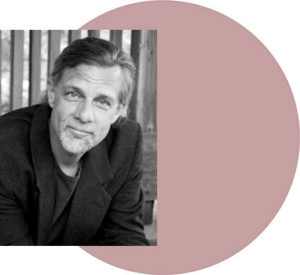
“I’m not crazy about reality,” opined Groucho Marx, “but it’s still the only place to get a decent meal.” We hope you find nourishment, inspiration, and even courage in the offerings on the menu of this edition of our in-house invitation-only Community of Writers journal. This end-of year OGQ features work from eleven of us. It includes the real-life story of a writer who boostered another writer, a craft talk by the poet laureate of the state of New York, and an affirming take on community via a documentary about a San Francisco dog park. Four fiction writers weigh in with careful and helpful insights into their own work. Two acclaimed poets with new books out share excerpts. A Screenwriting alum offers a moving and thoughtful meditation on end of life care. Finally, we get a sneak peek at the Marxist (Groucho) craft book by a staffer and all-around books booster whose “DIY manual for the construction of stories” arrives soon. We appreciate the generosity of these contributors, and are grateful for your readership. Please share the journal with fellow writers, students, family, and friends. Peace.
Andrew Tonkovich
Editor, OGQ

NOTES ON APPROACHING BEAUTY
By Patricia Spears Jones
“Astonish me”
— Sergei Diaghilev
“All changed, changed utterly: A terrible beauty is born.”
— W. B. Yeats, “Easter 1916”
“With beauty before me may I walk
With beauty behind me may I walk
In old age, wandering on a trail of beauty, lively;
In old age, wandering on a trail of beauty, living again…
It is finished in beauty.
It is finished in beauty.”
— Navajo Prayer
In my poem, “What Beauty Does,” several dynamics are explored: Nature, friendship, memory, healing, the West—the experiential character of travel, a heady mixture. But as poets we often explore and interrogate occurrences to find our way to beauty. While beauty is a noun with a basic meaning of “a combination of qualities, such as shape, color or form that pleases the aesthetic senses,” I would suggest that it is more of a verb—an action or condition that allows us to organize in language seemingly disparate elements to represent some form of harmony which may or may not adhere to “aesthetics” in that conventional sense since aesthetics are and should be contested. The “beau ideal” of the West has little to do with its counterparts in the East or South or North. You can tell I like direction, location, an on-the-landscape position. But out of our abstracted commentary on the knowledge we seek, culture changes, and beauty shift shapes yet again.
The quotes I chose are in some ways random, but not. They remind me that we continue to try to elicit the surprise, the ecstatic, in work. They also remind of the sustained eruption and disruption that is now our daily history. We are not in stasis. Indeed, static is not a word that comes to mind when thinking about the ideas of beauty that continue to reverberate unto this day. This is the one-hundredth anniversary year of the Easter Uprising. One hundred years ago, WWI was in full roar. Anti-colonial movements had started in Africa and Asia against European domination. The Bolsheviks were about to strike, “a terrible beauty” was birthing. Technology –the telephone, telegraph, armaments, war in the air—ushered that in. Out of this came Pound’s admonition to “make it new” and we have been involved in differing ways of making language that responds to the new “new,” which finds something in the way of beauty.
Yeah, Modernism is still with us in differing kinds of ways and because of it, our aesthetic senses have evolved, sometimes rapidly to meet new ways of seeing, emoting, bringing harmony out of chaos.
Often the way that poets explore beauty is through ekphrasis, which for some is almost exclusively visual. But I would suggest that is a limited way of looking at form. Indeed, I want to talk about the way in which what is claimed as beauty, aesthetics results from a disruption—sometimes out of violence, sometimes out of boredom, but mostly out a curiosity. So here are several poems by a range of poets who have approached the subject directly or indirectly in surprising, pleasing and disturbing ways.
I think disruption is useful. How else to change the way we see or taste or dance or feel. “Astonish me” was Diaghilev’s admonition to the members of Ballet Russes as they came up with dazzling, daring works. In this social media era where imagery that shocks but does not awe can be seen every second, one of the great things about poems is that they slow time so that, indeed, one may well be astonished.
I want us to look at several poems that slow us down, consider ways to approach beauty, organize other ways to show aesthetics. In the back of my mind is my now hometown of New York City where in September of 2001 two high towers were destroyed in an act of terror. An artist at the time was quoted and I am paraphrasing here, that it was a powerful work of art—and was vilified. But one of the things that art does is disrupt, destroy to make way for new. Three thousand people died and yet that sky returned. The terrorists were not artists per se, but in many ways this millennium is now trying to find ways to respond to these new dynamics. Disruption, interruption, and violence serve too often as the catalyst for these attempts, and we must recognize that. Kazim [Ali] has discussed the difficulties facing poets who do or do not choose to consider the political in their poetics giving all of us much to think about. But as someone who has, and knows poets who have done and continue to do these things — including many of you in the room — I would hope that we see his challenge to us as but one more way to enter the poem and make what it is the poet needs to make. The following poets in different ways use the tools of poetry to consider experience and create a “pleasing” aesthetic, but pleasure is complicated, and the poets understand complication.
Amaud Jamal Johnson’s “Aesthetics” shows us the familiar connection between violence — “we pinned back the wings/of butterflies” — to the necessary recognition of the startling power of what God or “the gods” make. As we know, most mass shooters practice animal cruelty before they pick up a semi-automatic and destroy humans. Johnson’s poem is also a reminder of how what we learn often leads to what we learn as the poem ends in an odd reverie. His use of the lyric and his formal devices preclude a kind of deaconship, a prelude to the priestly realms where “aesthetics” are explored through ritual.
Fortunately, in Marie Howe’s short lyric poem “The Copper Beech” the enormity of a tree provides solace and allows the speaker a gentle level of self-acceptance. Here Nature is seen as important and mysterious even on a “lawn.” Howe’s relationship to nature is domestic, the speaker is young, the tree has “immensity” —can shelter the girl in its generous branches. Here the use of couplets and that single line at the poem’s end gives breath to the tree and allows us as readers to join the poet in her practice of solitude even as we can feel the speaker desire to grow away from that lawn.
Maureen Owen’s poetry offer physical and psychic landscapes that sharpen how the beautiful separates the poet/the artist from her peers. “A group of girls from Minnesota or black mascara” has a comic edge that transform what seems the most banal of landscapes into a place filled with “neighboring galaxies” where “Giant Star Factories take control.” The language is banal and exuberant: “slender-toed geckos” […] “step onto the moon;” and she locates the time and space: “not where you stand but how long can you can” and the “trees are passersby/mercurial.”
Beneath the “Giant Star Factories,” a world unfolds as a kind of painting of a “flat orange moon/velvet navy-blue sky.” But why “black mascara”? Because “the beautifully attired drive tough Ford pickups” and “haircuts in London are pretty backward” — here is the language of style magazines — the gateway to beauty for many a teenager whether in the 1950s or now. This is an ordinary road trip, but then “Outside […] a refrigerator […] floats […] in the blackness shiny amid sharp stars” the poet observes how we cast our materials into the cosmos. And then she does something mirthful — she notes “the turtle who holds up the world […] holds up/the world.” That moment of letting go of the ideals of beauty, of material wealth and recognizing the cosmic order is a moment of finding a different way to talk beauty and indeed to be beautiful. The clash of ordinary objects: “refrigerator” with galaxies, “Giant Star Factories” and the girls’ trips to important yet banal events,” “2 baptisms and a shower” allow us to see the poet finding a way to contain these elements, to make something beautiful of the vast ordinariness of Minnesota. She is learning to “walk in beauty.” This is a kind of poem as collage, that leads to that sturdy turtle.
Owen’s work owes much to the New York School, to Buddhism, which she has practiced for decades, and to her feminism. But that New York School part is key-the connection among artists and writers and musicians may not be as strong as it was in the 60’s, 70’s, and 80’s, but the ways of seeing is now a powerful strand in American Poetics. Along with Anne Waldman, Bernadette Mayer, Ron Padgett, the now, alas, late Bill Berkson, Alice Notley and my other mentor, the late Lorenzo Thomas, Owen continues to explore ways to open up the spaces in poems, the break-apart language, to critique culture and to try and create something “new,” often inspired or intrigued by artists from other disciplines.
Ocean Vuong is a very young and intensely gifted poet whose work I’ve been reading for the past four years. His first full-length collection Night Sky with Exit Wounds is a deeply felt, spiritual and thoughtful exploration of his identities as a queer man, a Vietnamese immigrant. When I mentioned September 11 as part of the exploration of beauty, it seems matched by Ocean’s lyric poem, “Untitled (Blue, Green, and Brown): oil on canvas, Mark Rothko, 1952,” which makes a powerful case for how to shape beauty’s capacity to allow the cleansing of psychic wounds and to provoke a tonal shift in the conversation as he moves us not away from this event but brings us back into it. Here that “terrible beauty” is briefly explored with deftness and melancholy.
Untitled (Blue, Green, and Brown): oil on canvas, Mark Rothko, 1952
Beauty is not only in the eye of the beholder, but on the tongue of poets. I have been deeply impressed by the range of work in the workshops, but also the pleasures that poets are taking to finding new ways to discuss who and how we are and what we may become.
Anecdote: The most powerful altar I’ve ever seen was Union Square in New York City after September 11. When you walked out of the subway station the perfume from votive and scented candles greeted your nostrils. There were bouquets piled high and strewn-about posters asking, “Have you seen?” The names of people who we knew were now dead were on lampposts, fence posts, trees. People stood encircled, chanting or screaming or praying or arguing. There were people trying to sell stuff. Someone is always selling you something in New York. The scent of those candles cancelled out the combination of many perfumes, the sweat and urine that makes for many a city plaza. The people talked and chanted and screamed and argued and, yes, held to each other. It was a site of deep anguish and utter beauty. It was a birth, of what I do not know—a call for peace, a recognition of a world destroyed, a demand that those whose lives are interrupted by violence be remembered and, yes, for some, a call to war.
How we look/hear/taste/touch the world changes because new forms arise out of imagination, out of a need to confront new and old issues. Social injustice, racism, sexism, and homophobia are some of those issues. Whether we approach ways to consider beauty out of exuberance — “Astonish me” — or out of anguish —“Terrible beauty” — or from a great wisdom — “it is finished” — poets have the tools and resources to do so. I trust all of you will.
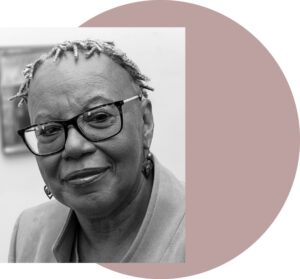 Arkansas-born Patricia Spears Jones has lived and worked in New York City since 1974. She is a poet, playwright, educator, cultural activist, and anthologist and has been appointed New York State Poet (2023-25). She is the recipient of the 2017 Jackson Poetry Prize from Poets & Writers. She is author of The Beloved Communityand A Lucent Fire: New and Selected Poems and three full-length collections and five chapbooks. At the Rauschenberg Residency, she published Collapsing Forrest City, Photo Giclée. Her poems are widely anthologized among them: 250 Years of African American Poetry: Why African American Poetry Matters Today, Plume Poetry 8; 2017 Pushcart Prize XLI: Best of Small Presses; WORD: An Anthology A Gathering of the Tribes; Of Poetry and Protest: From Emmett Till to Trayvon Martin, and Angles of Ascent: A Norton Anthology of Contemporary African-American Poets, and in journals such as About Place Journal; Paterson Literary Review; Cutthroat Journal; alinejournal.com/convergence; The New Yorker and The Brooklyn Rail. She co-edited Ordinary Women: An Anthology of New York City Women Poets (1978) and edited Think: Poems for Aretha Franklin’s Inauguration Day Hat (2009). Her plays Mother (music by Carter Burwell) and Song for New York: What Women Do When Men Sit Knitting (music by Lisa Gutkin) were commissioned and produced by Mabou Mines.
Arkansas-born Patricia Spears Jones has lived and worked in New York City since 1974. She is a poet, playwright, educator, cultural activist, and anthologist and has been appointed New York State Poet (2023-25). She is the recipient of the 2017 Jackson Poetry Prize from Poets & Writers. She is author of The Beloved Communityand A Lucent Fire: New and Selected Poems and three full-length collections and five chapbooks. At the Rauschenberg Residency, she published Collapsing Forrest City, Photo Giclée. Her poems are widely anthologized among them: 250 Years of African American Poetry: Why African American Poetry Matters Today, Plume Poetry 8; 2017 Pushcart Prize XLI: Best of Small Presses; WORD: An Anthology A Gathering of the Tribes; Of Poetry and Protest: From Emmett Till to Trayvon Martin, and Angles of Ascent: A Norton Anthology of Contemporary African-American Poets, and in journals such as About Place Journal; Paterson Literary Review; Cutthroat Journal; alinejournal.com/convergence; The New Yorker and The Brooklyn Rail. She co-edited Ordinary Women: An Anthology of New York City Women Poets (1978) and edited Think: Poems for Aretha Franklin’s Inauguration Day Hat (2009). Her plays Mother (music by Carter Burwell) and Song for New York: What Women Do When Men Sit Knitting (music by Lisa Gutkin) were commissioned and produced by Mabou Mines.
She curated programs as Program Coordinator for The Poetry Project at St. Marks Church and created WORDS Sunday series in Brooklyn. She has taught Creative Writing at Hunter College, Barnard College, Adelphi University and Hollins University as the 2020 Louis D. Rubin Writer in Residence. She has taught summer poetry workshops for the Community of Writers, Fine Arts Work Center, Naropa, Rutgers University, Truro Center for the Arts, and Wild Seeds Workshop for Medgar Evers College. In New York City she has lead workshops for The Poetry Project, Poets House, Brooklyn Poets, and Parachute Literary Arts. She is Emeritus Fellow for Black Earth Institute and organizer of the American Poets Congress.

MY SEARCH FOR ROBERT PLUNKET
by Victoria Patterson
My father and brother, earnest born-again Christians, decided to make a pilgrimage to Israel on a guided two-week tour offered by their megachurch. Despite my historied vocal animosity of their politics and religion, our estrangement over the Trump years, and our tenuous reconnection, based mostly on never discussing anything deeper than the weather, I tried to muscle my way in. I’m fated to pine for familial connections that don’t exist. When I couldn’t cover the five grand fee, my plan was scrapped. Everyone was relieved, including me. Why, asked my therapist, why, asked my husband, why, asked our sons, why, asked my friends, why, asked strangers, would you go to Israel with a group of right-wing Christians? You’d be in hell. Probably, I said. But I’d take notes.
Around the time they were flying home, I decided on a very different pilgrimage. I texted my friend Michael Leone and asked if he wanted to join me in Sarasota, Florida, to meet the 78-year-old writer Robert Plunket. Plunket’s comic masterpiece, My Search for Warren Harding, after decades out of print, had been republished by New Directions, and he’d recently been profiled by The New Yorker.
Michael Leone and I had met at the Community of Writers in the Olympic Valley many summers before, and a lasting literary bond was forged. Along with being hilarious, kind, and a talented writer, he’s my primary go-to for book suggestions, which is how l first learned about Robert Plunket.
We’d played a part in Plunket’s resurrection, a rare example of literary justice. In 2015, I published an essay about Plunket and MSfWH for Tin House’s “Lost & Found,” and soon after Leone interviewed Plunket for the Los Angeles Review of Books. Years later during the height of the pandemic, I lent my frazzled copy of MSfWH to my friend, the writer Danzy Senna. Soon after, she fell for the book as well–and sent it to a friend of hers, an editor at New Directions. The republication of MSfWH has been a source of joy.
Neither Leone nor I had met Plunket in person, but for years he’d lived large in our imaginations. It wasn’t just that he’d authored one of our favorite novels. Google him: he collects rhinestone costume jewelry and Juicy Couture; a pug lover, he facilitated pug parades for years; he was Mr. Chatterbox, the longtime gossip columnist for Sarasota Magazine; Madonna was a fan, and wanted to make a movie out of his second novel, Love Junkie; he has a cameo in the film After Hours; Clifford Irving, the great hoaxer who wrote the fake autobiography of Howard Hughes, was his friend (whom he found fascinating), as is actor/director Griffin Dunne and actor/producer Amy Robinson.
I won’t speak for Leone. But after the pandemic (I know–Covid’s not over yet), an embarrassment of personal misfortunes, a painful split from my longtime editor and publishing house, and the depressing reality of the publishing world, I was eager to prolong the euphoria of Plunket’s well-deserved, long-overdue recognition.
Leone emailed Plunket to ask if we could visit. Within minutes, Plunket responded: It might be a lot of fun. Or it might be a disaster. Either way it will be good material for all of us.
Simple, right? Leone and my countless hand-wringing-projection of texts proved otherwise: Don’t meet your heroes! What if he hates us? What if he’s a total asshole? What if he ghosts us?
I bought my plane ticket. Nauseated and eager for Leone to order his, I texted: I pulled the trigger. From the eye doctor’s, he texted back: Wow okay. I just got dilated so I can barely see.
While waiting to be herded onto the plane at LAX, during the flight to Atlanta, throughout the layover, on the flight to Sarasota, and, finally, lying in a lumpy bed at our Airbnb, I reread MSfWH and discovered that a), it’s as funny and brilliant as I remembered, and maybe more so; b), the New Directions’ handsome reissue is a far more luxurious read, the pages thick and creamy to my fingertips, especially in contrast to the old raggedy, crumbling paperback from years ago; and c), everyone around me, including myself, took on qualities of the novel’s hilariously misbegotten characters, as if we, too, belonged inside its pages.
There was, for example, the Sarasota Avis car rental agent with a slight speech impediment who favored turquoise jewelry–rings, bracelets, and an impressive braided leather bolo with a chunky stone at his throat. Occasionally jerking his head as if dislodging a fruit fly from his ear, he talked me into renting a black Tesla for the same amount as a Toyota Corolla. A great deal, he insisted, and only available because I was the last customer on his shift.
Leone and his soon-to be-sixteen-year old daughter, Alex, arrived in Sarasota on a later flight, from their home in New Jersey. After struggling to open the Tesla’s door (I never got the knack of waving the key fob at hidden spots), I picked them up at the airport. Leone and I hadn’t seen each other in over ten years, yet, as the cliché goes, it seemed like yesterday.
Soon Alex was looking out the car window with an expression of horror as Leone and I passionately sang along to the Smiths’ “Still Ill,” playing at high volume: But ask me why and I’ll spit in your eye! My sons are now young adults, but I quickly thrilled to the forgotten pleasure of embarrassing a teenage hostage.
Our Airbnb in Palmetto was in a quiet, working-class neighborhood of modest homes sporting DeSantis 2024 flags and MAGA flags. Iridescent pink lizards the size of my forefinger proliferated, doing pushups and springing around (I didn’t know lizards could jump like that). As we settled in, they plastered themselves to the house’s windows, innocent precursors to the lounging alligators we’d later spot from a bridge overlooking a swamp.
Leone had texted Plunket from his Chicago layover: Hello? Is this THE Robert Plunket of the masterpiece MSfWH–it’s Michael. En route from Chicago. Plunket’s response: Hurry–I’m getting hungry.
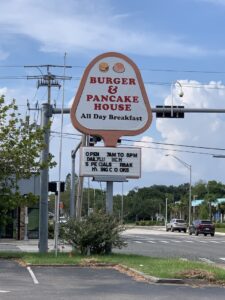 We agreed to meet at a restaurant called Burger & Pancake House at six p.m. Leone and I were both apprehensive, thinking that this might be our sole opportunity to know the man.
We agreed to meet at a restaurant called Burger & Pancake House at six p.m. Leone and I were both apprehensive, thinking that this might be our sole opportunity to know the man.
Balmy hot, muggy like an air-bath, go outside and sweat-spot your shirt, soon I was silently cursing the bolo-wearing Avis rental agent, as the AC and fan rapidly drained the Tesla’s battery, requiring us to find a charging station to “fuel up.” No wonder he gave me such a deal!
Two minutes past six, Leone, Alex, and I walked inside the empty diner–empty except for Plunket, who sat alone at a table. “You’re late,” he said, flatly.
He wore a gray T-shirt and looked like a slimmed down Floridian Santa Claus, beard trimmed. The restaurant soon became crowded. I had an omelet with a side of grits slathered in melted cheese. The portions, as Plunket warned, were enormous. The sound system played the Eagles and other soft rock, mostly from the 70’s.
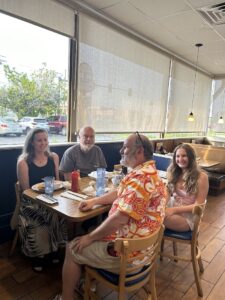 The dinner was cordial, maybe a little restrained. We talked about the surprise of his book finally getting published, the media exposure, and how a writer from The New Yorker came down and spent three days with him. He forked his leftovers into a Styrofoam container, probably for his longtime partner and “adopted son,” Tom Cate, who was “very shy,” and had declined to dine with us. We said goodbye in the parking lot, Plunket showing us his brand new white KIA. “So what about tomorrow?” he said.
The dinner was cordial, maybe a little restrained. We talked about the surprise of his book finally getting published, the media exposure, and how a writer from The New Yorker came down and spent three days with him. He forked his leftovers into a Styrofoam container, probably for his longtime partner and “adopted son,” Tom Cate, who was “very shy,” and had declined to dine with us. We said goodbye in the parking lot, Plunket showing us his brand new white KIA. “So what about tomorrow?” he said.
Later I couldn’t sleep, reliving the dinner with 10cc’s “I’m Not in Love,” now an ear-worm inside my head. Had I talked too much? Were the gifts I’d foisted on him–a mug decorated with pugs flying on sprinkled donuts like magic carpets and a small tea-packet disposal plate from the Barbara Pym Society of North America–too silly?
I sang the 10 cc song for Leone the following morning. He said that he’d been so jacked up at dinner, he hadn’t noticed any music. We both interrogated our behavior in front of our worthy guest. We agreed that we’d competed like needy siblings for Daddy’s attention. And clearly, I’d startled Plunket with my gifts.
But whatever and however our first meeting went down, however manic we must’ve seemed at dinner, we somehow passed Plunket’s test, because he virtually took over as a Sarasota chaperone and cicerone for the next four days.
The next morning we were to meet him at his trailer park, which was nothing we’d envisioned. A mannequin dressed as a security guard with a trim mustache greeted us at the gate. (“I still don’t know,” Plunket said later, about the mannequin, “if the residents are sincere or if they think it’s funny.”) Charming prefabricated houses with robust gardens and bushes snuggled together at a park. There were cute diminutive old fashioned streetlights, a manufactured pond with a fountain in the middle, and a swimming pool.
Entering Plunket’s house, we met Tom Cate, who was sweet and shy, and their jolly, chunky, gray-muzzled black pug, Meatball, a wheezing delight, whose hind leg thumped as he scratched at a mystery-scab tucked into one of the folds on his neck. Before we left on our tour, Plunket clipped a cone around the dog’s head.
Leone asked permission to inspect the small bookcase against the wall.
“Sure. Ask if you have any questions.”
A few titles interested me in particular: Betty MacDonald’s Anybody Can Do Anything, Barbara Pym’s The Sweet Dove Died, and E.F. Benson’s Mapp and Lucia. I said that I’d not heard of Betty MacDonald and Plunket insisted, “Start with The Egg and I.”
As we walked to the Tesla, Plunket said that his neighbors were mostly gone in the summer. Friendly and nice, they seemed not to know what to make of him, Tom Cate, and Meatball. None read, so they had no idea who he was.
I’d drive and Plunket would direct from the passenger seat. “We’ll test the arrangement,” Plunket said, as we settled into the Tesla. Mostly blind in one eye, his peripheral vision stunted, he warned that he had a unique form of dyslexia where it was difficult to discern left from right, so he’d probably wave his hands at me.
Our first destination was the Gamble Plantation Historic State Park in Ellenton, an antebellum mansion and sugar plantation; we knew we were getting close when we passed the Plantation Dialysis Center. Plunket told us that the real life Confederate soldier Judah P. Benjamin, Jewish and gay, and also a character in the novel he’s working on now, hid inside the plantation’s mansion. He pointed out the balcony where Judah would study the river to see if the Union soldiers were coming for him or if his ride to the Bahamas had shown up yet.
We truly had the insider’s Sarasota tour: the keys, the mansions, a Mexican market, the hidden architectural gems; even Plunket’s dentist’s building and Meatball’s veterinarian, where, Plunket said, Meatball would scream anytime they neared and/or drove past the building.
When Leone and I didn’t know the Sarasota architect, Paul Rudolph, one of the pioneers of the Sarasota School of Architecture, Plunket closed his eyes and sighed heavily. But then I became an even worse philistine for not fully appreciating the modern architecture he showed us. After that, whenever we passed a modern house or building, one of them would say, “Well, that’s just not good enough for Tory.”
We drove by his friends’ houses, including one who no longer speaks to him because of an apparent misunderstanding about inheriting Plunket’s former KIA (“Go, drive, drive,” Plunket exclaimed, waving me forward, “before he sees us and thinks we’re stalking him!”); we cruised the house of another person who no longer considered Plunket a friend, because he didn’t write about “nice people.”
Plunket is soft spoken and gentle, and very witty. Leone is also very funny, especially in private. I laughed so much, I forgot to be anxious or ingratiating.
Over the days, we had long, meandering conversations about writers and writing, and we gossiped a great deal, too, about the Sarasota folks, and also other writers. Why were certain male authors cancelled, like the one in a mesh shirt in a bathtub during a zoom; but others not, like the one who twitter-posted a bleary-eyed mirror-selfie from a plane’s bathroom, his penis a dark-pink slug plopped outside his unzipped pants?
“Oh,” said Plunket, with a dismissive hand wave, “he was drunk and high. What else is there to do on such a long flight.”
We teased each other mercilessly and affectionately. The second time Leone immediately launched himself at Plunket’s bookshelf, Plunket said, “That’s rude, like rifling through my medicine cabinet right in front of me.”
There was an ongoing joke about setting up a now-single Leone (he’d broken up with his girlfriend days before our trip) with a wealthy Sarasota widow. Plunket showed us her Facebook page (in her sixties, she nevertheless looked like Emily Blunt), and then inspected Leone’s page, asking point blank: “How much money do you have in your bank account?”
Plunket said he’d like to go on a cruise with us next. We both scoffed, and I asked if he’d read David Foster Wallace’s essay, “Shipping Out: On the (nearly lethal) comforts of a luxury cruise.”
“Oh, my god, I hate that essay!” he exclaimed. “What a condescending snob!”
Interested to really know us, Plunket probed, asked questions about our personal lives. Childhoods were discussed, relationships, family histories, our insecurities and doubts. He had us clarify statements.
“Jeez,” Leone said once, after making a general proclamation. “I didn’t know that I’d have to back my claim with examples.”
Later Leone would say, “I talked more in four days than I have in a year.”
Plunket gave us writing tips. (Sorry, I’m keeping those to myself.) We learned that he writes in the mornings and edits in the evenings. We talked about how people noticed themes in our work that we hadn’t fully known we’d created.
“Like shame,” I said.
“Oh, I just adore shame,” he said. “Shame and sex go together so well!”
We witnessed Plunket’s friends love for him and his love for his friends. Like Pam Daniel, his forty-plus year editor at Sarasota Magazine, who opened her home to us.
That night, Plunket came to our Airbnb, so that he could see it. I lit a few candles and played music on a portable speaker.
Since the Tesla had pooped out, its battery once again drained, we clambered into Plunket’s KIA this time.
The drive to Pam’s was long, he said, and the way back would be in the dark. “If I start weaving or bumping into things and scare you, tell me to pull over, and then you can drive.”
First, we stopped at a fancy market on the Siesta Key, and bought a couple of ornate pies for dessert.
At Pam’s, gazing at a generational portrait of three primly-dressed women (sisters and mother?) from the fifties, Plunket mused, “So which one’s the slut?”
We sat outside on Pam’s dock and had drinks and dinner. The guests included Kay Kipling, the former arts editor at Sarasota Magazine. Conversation was easy, lots of laughter, and the topics included DeSantis’s rise, Taylor Swift’s popularity, trans identity, and the social circle of wealthy Sarasota wives. The sun sank, slowly purpling the sky. A green light orbed the water below us, and we watched the sea life swarm the lighted space.
When the bugs started biting, we moved inside. Kay spread photographs of their times together at social functions onto a coffee table. Sailboats, parties. With their permission, Leone and I took a few home. In one of mine, Plunket, cocktail in hand, gapes at a statue of Andy Warhol.
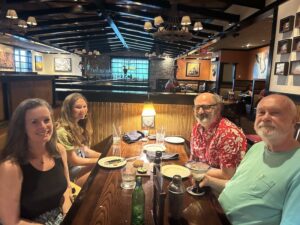 Our final night was to be at Longhorn Steakhouse. In a dim-lit booth Plunket raised his daquiri. “So, was I what you’d expected me to be?”
Our final night was to be at Longhorn Steakhouse. In a dim-lit booth Plunket raised his daquiri. “So, was I what you’d expected me to be?”
There was a pause, and I sensed a shared decision to forego sarcasm and silliness.
“Better,” we said.
“How so?” he asked.
We said that he was hilarious, of course, but that he was also generous, adventurous, and so much fun.
Were we what he’d expected?
He knew that Leone would be okay, he said, since Leone had interviewed him for the Los Angeles Review of Books, and they’d kept in touch.
“I was the wild card,” I prompted.
“I thought,” he agreed, “that you’d be far more snotty.”
Home a few weeks, I tried to explain to my brother the importance of my pilgrimage. Leone and I had just received an email from Plunket, attached was a glowing review of MSfWH in the inaugural relaunch of Bookforum. He’d written: Miss you guys.
My brother didn’t understand. He had Israel, I said, and we had Robert Plunket’s trailer house in Sarasota, Florida. To each his own. Like him, my faith had been renewed.
Leone and Plunket reminded me that being a writer can be a gift, with or without publication, rewards, monetary compensation, and acceptance, familial and otherwise.
A keen eye, sharp wit, marginalized outlook. Sure, it can be lonely and isolated. But when connected to likeminded others? What joy.
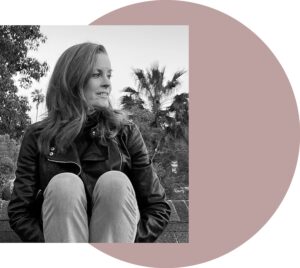 Victoria Patterson’s latest story collection, The Secret Habit of Sorrow, was published in 2018. The critic Michael Schaub wrote: “There’s not a story in the book that’s less than great; it’s a stunningly beautiful collection by a writer working at the top of her game.” Her novel The Little Brother, which Vanity Fair called “a brutal, deeply empathetic, and emotionally wrenching examination of American male privilege and rape culture,” was published in 2015. She is also the author of the novels The Peerless Four and This Vacant Paradise, a 2011 New York Times Book Review Editors’ Choice. Her story collection, Drift, was a finalist for the California Book Award and the Story Prize and was selected as one of the best books of 2009 by the San Francisco Chronicle. She lives with her family in Southern California and teaches at Antioch University’s Master of Fine Arts program.
Victoria Patterson’s latest story collection, The Secret Habit of Sorrow, was published in 2018. The critic Michael Schaub wrote: “There’s not a story in the book that’s less than great; it’s a stunningly beautiful collection by a writer working at the top of her game.” Her novel The Little Brother, which Vanity Fair called “a brutal, deeply empathetic, and emotionally wrenching examination of American male privilege and rape culture,” was published in 2015. She is also the author of the novels The Peerless Four and This Vacant Paradise, a 2011 New York Times Book Review Editors’ Choice. Her story collection, Drift, was a finalist for the California Book Award and the Story Prize and was selected as one of the best books of 2009 by the San Francisco Chronicle. She lives with her family in Southern California and teaches at Antioch University’s Master of Fine Arts program.

EPITHETS
by Molly Giles
I was recently interviewed by a woman who wanted to know how it felt being an “older writer.” I was up for this, but my heart sank when she asked why I chose to write about women in their fortieth decade. Fortieth? Wouldn’t that make them…like…really old? I peered through my bifocals at the pretty blonde on the zoom screen. She looked sad, so I decided not to correct her. “It’s definitely an interesting age,” I offered. The interviewer sighed in agreement, and we moved on:
Do you write more quickly now that time is running out? Do you write more slowly because your brain has slowed down? Do you tire faster? Has your life as a writer changed over the (long) years? Has your writing style changed over the (long) years? Do you have any tricks for keeping the creative spark alive? What keeps you going?
I answered gamely, no no no no no no, and: I don’t know. But I balked at the last question: What do you want your epitaph to be?
Epitaph? As in, “Here lies….?” It’s true my friends and I talk more about new hips than new relationships these days and we have had spirited discussions about whether we want to be buried or burned. But we haven’t talked about actual gravestones. I told the interviewer that I would be fine with anything, unless some young stonecutter carved “Here lays” at which point I would rise up from WhereEver and give him or her WhatFor. But as for choosing my own words? It seems to me an epitaph is a sort of blurb and we writers aren’t usually asked to blurb ourselves, though we are usually required to write most of our book jackets. So I told her my epithet was up for grabs and if she wanted it, the job was open.
Safe on the topic of book jackets, I volunteered that one of the trickiest parts about being an older writer is getting a new photo. Using an earlier photo, which many of us do, feels like a cop-out, but getting a true-to-life-but-not-that-true-to-life photo is depressing. There is some comfort in knowing that whatever photo taken today is going to look better than any photo taken ten years from now, and there is comfort too in accepting the new old you. Fortunately, I have always liked the way old people look. My grandmother, with her faint mustache and rouged cheeks, was the love of my life. Unfortunately, I don’t look a thing like her.
The pretty blonde nodded, still sad, mainly because, she finally confessed, she was dreading her upcoming birthday—she was about to turn fifty—fifty! –and we spent the rest of the hour talking about her, which was a huge relief. I assured her that the fifties were fine, the sixties were even better, and the seventies were great—I spent my seventieth birthday in Rome, alone, having a wonderful time, and I fell in love with my present partner when I was seventy-five. “So there’s hope?” she asked.
There’s always hope. Here are some of the perks of being an older writer than I failed to touch on in that interview:
- You have more to write about.
- You know the beginning, middle, and often the end of a lot of stories.
- You can write about departed friends and loved ones without hurting their feelings.
- You can face the fact that you are never going to finish that novel about the schoolteacher who lived in a grass hut or that young actor’s fateful pilgrimage to Hemingway’s house in Piggott and you can carry those moldy boxes of papers and dump them in recycling, lingering by the bin to savor the whoosh.
- You can reread your journals. They were written by an unlikeable stranger, but they have some scenes you can steal.
- You can read new books by young writers without wanting to beat them up and you can reread books by old writers without wanting to sleep with them.
- You no longer want to write about sex. Or death. You’d sort of like to write about food but there’s the problem of plot.
- You have a new if hard-earned knowledge of anatomy and you know a lot more about pharmaceutical products than you used to.
- You find great material at memorials: people say all sorts of things, plus there is usually as much cake as at a wedding, the dress isn’t as formal, and you don’t have to dance.
- When someone at a reading asks what your epitaph is, you can smile, pretend to be even deafer than you are, and say “Next?”
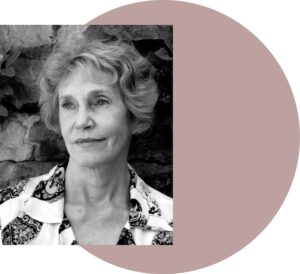 Molly Giles is the author of five award-winning short story collections (Rough Translations, Creek Walk, Bothered, and All The Wrong Places) and a novel, Iron Shoes. Her collection of short stories, Wife With Knife, recently won the Leap Frog Fiction Contest and was published in October of 2021. Her new novel, The Home for Unwed Husbands will be published by Leapfrog in spring 2023. Her memoir, Life Span, will appear in 2024. She attended the Community of Writers Summer Workshop a thousand years ago as a scholarship student and has happily returned as student and staff member many times since. She has won an NEA, an NBCC award for book reviewing, and has taught Fiction Writing at San Francisco State University and The University of Arkansas in Fayetteville.
Molly Giles is the author of five award-winning short story collections (Rough Translations, Creek Walk, Bothered, and All The Wrong Places) and a novel, Iron Shoes. Her collection of short stories, Wife With Knife, recently won the Leap Frog Fiction Contest and was published in October of 2021. Her new novel, The Home for Unwed Husbands will be published by Leapfrog in spring 2023. Her memoir, Life Span, will appear in 2024. She attended the Community of Writers Summer Workshop a thousand years ago as a scholarship student and has happily returned as student and staff member many times since. She has won an NEA, an NBCC award for book reviewing, and has taught Fiction Writing at San Francisco State University and The University of Arkansas in Fayetteville.

by Sarah Maclay
Real State
Thou shalt hang thy blankets from a tree
or thou shalt score a gig as a retail doorman on Rodeo
Thou shalt cover thyself with a sheet of clear plastic and kick at the corner of
Broadway and 6th, while pedestrians pass
Thou shalt fumble for keys at the end of the night shift, still in scrubs
Thou shalt hang a right in thy pre-owned 911 Carrera
Thou shalt remove all personal belongings from thy cubicle before the end of the
business day. Here’s a box.
Thou shalt spring for the 27-thousand-dollar beaded gown not far from the Bois
d’Argent
Thou shalt prop the mattress against the eucalyptus across the street from the house
in escrow, the two-story for lease, and the reno covered in Tyvek
Thou shalt park thine SLK 320 under the sycamore leaves
Thou shalt not be able to light your cigarette in the wind as you sit on the stoop
behind the open storefront display of wighead mannequins
It’s an economy storage box
Thou shalt pick up the tab on the ornamental 13-thousand-dollar Buddha and that
6K bottle of scotch in the duty-free
Thou shalt dry thy clothes on the guardrail in front of the Walgreen’s and Shabu-
Shabu
Thou shalt walk with weights in the evening as the sky turns amethyst then amber
and the water comes on, inches from the rusty grass
Drive 45 on the boulevard
Thou shalt leave the couch and the plastic plant on the curb at the end of the month
Thou shalt load the Relo Cube for pickup at Glyndon and Vienna
Thou shalt live in the back of a 1950s Buick with shattered glass
You can use the wi-fi at the Starbucks next to the Dollar Loan
Thou might get a construction job on the northern side of the National Rent-A-
Fence
Thou shalt put the tents up after the shoppers leave
Thou shalt no longer be able to afford the unpermitted room within earshot of
gunshot and helicopter
Thou shalt “join the 17 million readers who have fallen”
Thou shalt try to sleep in the late afternoon at the base of a streetlamp on the hidden
side of a Shell in the Marina
Thou shalt lose thy shirt selling armor, rugs, and chandeliers
No Parking Any Time
Thou shalt stick two signs in the lawn: “house for lease” and “tutoring”
Thou shalt check the stats on the listings from the last six days
Thou shalt organize thy belongings carefully under the overpass
Thou shalt not vacate the premises without giving a 30-day notice
Thou shalt guard the tents at Venice & Globe
Open door policy
Thou shalt not sleep except upon a concrete floor
After Vuillard
House is a dappled construct
House is a shadowed land on a small hill
House is before the abundant garden—
The birdlike stems and butterflies
Of flowers pirouetting,
Nearly as large as the windows,
Or leaves like yellow diurnal bats
House is behind the woman in the satin pink kimono,
Face as large as the first floor
House is the tiny gardener,
Head as big as a rose,
Inspecting the hedge
Perspective is filigreed blue shadow
Below the white hibiscus, stamens
Longer than a hand
Windows turning red as the roof in the evening sun,
Red as the tallest floribunda
Is the woman with rose-petal hair
In the lattice of shadows, handing—
Is the dark canoe-shaped shadow on the roof
The figure behind the open curtain
The closed cerulean shutters—
Their slightly aged pastel, the texture of their rough wood
The door thrown open
The hot sweet smell of summer-singed pollen
The soft sounds of garments landing on the floor
Is for sale
Is her blue hat
Is the cracked tectonic floor
Is no longer there
Is the sun hitting the pavers, the terraced, dry dirt steps,
The chair
The thorns
Perspective is the removed corset
Longer than petals
The flying light
The light flying
Night coming on, to the left
Above the acacia, below the pine
Illuminating the chorus line of genies
Playing their bagpipes
As the cannas and the ultimate dwarf bearded irises
Unfurl, unravel, nearly ragged, vulvic, utterly,
And the whole yard is full of flying things
Abundantly tethered enough to stay in position
For a time
For this moment
The blue, I’m telling you, I can’t make out
Though it’s closer to larkspur than indigo,
Closer to denim, closer to bamboo
I guess I should be happy
How does it speak?
Letter Almost Sent
You won’t like this.
Maybe you won’t want it.
I’m lying here in the dark with my burning candle—
otherwise, it’s still. I tried again
not to think of you today.
It was so cold, even though it’s still September, that I had to wear two coats.
It wasn’t quite enough.
By nightfall, it was brisk—leaves already golden,
fallen, wet.
We walked quickly, my friend and I, from the parking lot
to the symphony. I made it nearly to the end of the Rimsky-Korsakov—
all the way to that crescendo and quickening, that cymbal crash—
and then
in the place where things go suddenly quiet, but alive—
into that barely audible, sustained, pianissimo pulsing
—lingering—
exactly like it always is when we’re together, after—
holding each other—
exactly like this
but in sound.
You must listen.
How could it have been composed without this private knowledge—this experience?
It was shocking. To understand this. I can smell your skin.
They say he used to compose while walking along the footbridges
between the bulrushes and bending willows,
the gardens and the lake.
The Germans leveled the summer house where he wrote it.
I so hope you’re ok.
Don’t worry. I know nothing can happen.
Though this feels so strange.
Can’t not think of you at night in the ice palace of Varykeno
(so cliché, I know)—
crystalline, deserted, filled with snow—
even though we know it wasn’t constructed on the steppe,
but in a studio lot near Madrid,
not far from the airport—
the ice made out of cellophane
and paraffin;
the snow a mix of aspirin powder and soap flakes
—just as hard to walk through as real snow:
Not ours to enter.
And anyway, it doesn’t exist.
Forgive me.
P.S. My brother and I spent several hours
trimming the apple trees in the yard
as sunset flecked its pink and orange against gray.
We caught it just in time.
Notes
“Real State”: after Moses, Hockney, Bosch
“After Vuillard”: after Vuillard’s “Garden at Vaucresson”
“Letter Almost Sent”: after Rimsky-Korsakov’s Scheharazade, after Pasternak
Acknowledgments
Grateful acknowledgment to the editors and publishers of these journals and anthologies, where the following first appeared:
Pratik – The Ghosts of Paradise: “Real State”
Tupelo Quarterly: “After Vuillard”
“Letter Almost Sent” is included in the anthology Written Here, from the Community of Writers.
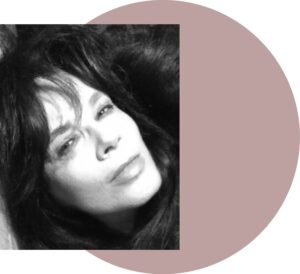 Nightfall Marginalia (What Books Press, 2023) is Sarah Maclay’s fifth collection. Her poems and essays, supported by a Yaddo residency and a City of Los Angeles Individual Artist Fellowship and awarded the Tampa Review Prize for Poetry and a Pushcart Special Mention, among other honors, have appeared in APR, FIELD, Ploughshares, The Tupelo Quarterly, The Writer’s Chronicle, TheBest American Erotic Poetry: From 1800 to the Present, Poetry International, where she served as Book Review Editor for a decade, and beyond. She teaches at LMU and offers workshops at Beyond Baroque, roaming between LA and her native Montana.
Nightfall Marginalia (What Books Press, 2023) is Sarah Maclay’s fifth collection. Her poems and essays, supported by a Yaddo residency and a City of Los Angeles Individual Artist Fellowship and awarded the Tampa Review Prize for Poetry and a Pushcart Special Mention, among other honors, have appeared in APR, FIELD, Ploughshares, The Tupelo Quarterly, The Writer’s Chronicle, TheBest American Erotic Poetry: From 1800 to the Present, Poetry International, where she served as Book Review Editor for a decade, and beyond. She teaches at LMU and offers workshops at Beyond Baroque, roaming between LA and her native Montana.I’m standing on the rooftop of my 1920s Hollywood apartment building, the Afton Arms, and to the west I see a glint of Pacific Ocean. It’s a hot April afternoon, and fretful Santa Ana winds churn and swirl around me. Palm trees creak and bow, and thin clouds skitter across the sky. I come to the roof to get perspective, literally and figuratively, and walking to the edge, I feel a rush of vertigo. A gust of wind pushes against my back, and if I’m not careful, it feels like I might fly over the side. I work in a local bookstore, and though I spend my days surrounded by words, I’m not a writer yet. I’m trying to decide whether to follow a boyfriend to Texas or stay in Los Angeles. I’m trying to decide what to do with the rest of my life.
The Afton Arms was built to look like a castle, complete with a faux bell tower. Across the courtyard, I can see my apartment—the ivy-covered turret, which houses my kitchen, and the tiny hexagon-shaped window in my bedroom. I close my eyes and inhale the smell of night blooming jasmine, exhaust, and fresh bread from the bakery down the street. When I open my eyes and look down, I see her—the girl on the lawn. For a week she’s been sitting on the grass outside a metaphysical center near a sign that reads “Impossible Possibilities.” The metaphysical center is windowless and covered in pink stucco, the pale pink of a baby’s palm. The girl sits on the lawn for a couple of hours, sometimes longer, sometimes late at night, as if the curtain of evening makes her invisible. She sits with her legs neatly canted to the side in a way that brings to mind a private girls’ school—good sweaters, gold lockets. Except this girl is barefoot, dirty, and deeply sunburned. She wears a crop top with little daises on it. I’ve never seen her ask anyone for change. I’ve never seen her ask anyone for anything. The girl absently tugs at the grass, then without warning, looks up at me on the roof and we lock eyes.
*
Although I’m not a writer yet, I’ve recently begun to jot things on index cards—images, words, phrases that capture me. I keep them in a cigar box where I imagine a kind of gathering process will occur. I write “the girl on the lawn” and slip it into the box.
At the suggestion of a friend, I take a writing class. I’ve never written fiction before and sign up for a mixed level workshop taught by a teacher I pick because I like his name—Jim Krusoe. Unbeknownst to me, he’s one of the best writing instructors with whom one could ever study. Before the workshop starts, students mill around discussing their publications and books, throwing around craft terms, and I have no clue what anyone is talking about. I make it through the first hour of the workshop, but at the break, I flee. I’m too scared to take the class. Only much later will I realize that a seizing connection can masquerade as fear, that something which will become the organizing principle of your life can initially terrify you.
*
The next day when I arrive home, I see her again, the girl on the lawn. It’s almost ninety degrees, the air smells like pennies and burnt sugar, and the troubling winds won’t let up—earthquake weather some would say. The girl hasn’t left the lawn since morning, and I worry it’s because she’s shoeless, and the pavement is hot. I approach her but stop about six feet away, as if I’ve stepped through an invisible doorway to her home. To move closer seems disrespectful. “Do you need shoes?” I ask.
The girl lifts her head and squints at me. No response. I’m not sure she heard my question. “Can I use your shower?” she asks. Her voice sounds drifty, like a late-night radio show caller with a bad connection, the type the host cuts off.
I glance over the girl’s head at the metaphysical center, shut tight as a sleeping face, still pink. “Now?”
“I’ll clean your bathroom,” she says.
“What’s your name?” I ask.
“Why?”
A trickle of perspiration runs down my back. I wonder how old the girl is and decide we might be about the same age. We might have gone to high school together. The girl brings her index and middle fingers to her lips, as if she is considering something—a delicate, refined gesture. “Nancy.” She smirks and stares straight ahead, as if she already knows my answer will be no.
*
Nancy follows me into my apartment building like someone coming out of anesthesia. She steps into the foyer cautiously. “This way,” I say to her, though there is only one hallway.
Nancy stands in the middle of my living room and sneezes. “You have any tiny time pills?” Emphasis on time. And for the first time I notice an accent, maybe Southern.
“I don’t have pills.”
Nancy sneezes again. “Contac. You got Contac?”
“I don’t think they make it anymore.”
Nancy stands motionless and waits like she’s a person at the end of a long line who has little hope of making it to the front.
“So, there’s the bathroom,” I say, and Nancy enters it and shuts the door before I can give her a towel. She’ll find only my own, hanging on a hook near the shower. I wait in the hallway and listen to the water run at a trickle, nothing more.
Minutes later, Nancy steps out of the bathroom. “I cleaned after myself.” Her hair is wet, and her top and jeans are damp in spots. Rather than use my towel, she didn’t dry off. “You have a boyfriend?” she asks.
Because I’ve seen Nancy’s life on the lawn and there is no other person it, I lie. “No boyfriend.”
Nancy pulls a cigarette from her pocket, puts it in her mouth.
“I’m sorry, you can’t smoke.”
She picks a piece of tobacco off her tongue and stares at me. “I know the day you’re going to die, want to hear it?”
“How could you know that?”
“I’m psychic. I see things.”
“Thanks, no.” I laugh but Nancy doesn’t.
She bites her lip, and I realize she’s stalling for time. “You work?” she asks.
For a crazy moment I want to say I’m a writer but don’t. Impossible possibilities. “I might move to Texas.”
“Sure,” says Nancy. “Sure.” For a moment we share an easy familiarity, as if we often chat about our futures. We fall silent again. I ask if I can help her get into a shelter, and Nancy studies the floor. Finally, she says, “I always wanted to live in a castle.”
We stand there looking at each other. “I’m sorry,” I say. Nancy flinches and turns away. I try to give her a pair of shoes, but they don’t fit. I ask her if she needs money, but she shakes her head. I hand her a twenty, anyway. I tell her I’ll help her again.
After Nancy leaves, I watch her from my living room window. She steps onto the sidewalk and turns, as if someone had called her name. Walks a few feet. Stops. Looks up at my window. Then slowly, very slowly, she walks away like someone treading the bottom of the ocean.
*
The next day, the girl on the lawn will be gone and she’ll never come back. I decide to stay in Los Angeles rather than follow someone else’s dream. I find the courage to return to the writing class, and in response to an assignment, I write about Nancy—
The girl on the lawn grew up in a town slit open by a one-way highway. Before the highway, the town was filled with cows, silent people, and lilac bushes at every turn. There was a rumor that you could walk the highway straight across the country, and the girl ached to do this.
The girl on the lawn played flute. She had beautiful embouchure and an astonished look like someone flung into a snowbank by a person who deeply loves her. Each day the girl on the lawn stole a little bit of money from every member of her family, never enough to be caught. The girl on the lawn was not dumb. The girl on the lawn was like a million other girls that rise up like a flock of birds and turn, all at once, toward Los Angeles.
*
Many years later I’ll write a novel, Burst, about a nomadic mother and daughter who must rely on the kindness of strangers, about a girl who believes she’s psychic, and the Afton Arms rooftop will anchor the final scene of the book where a mother and daughter are running around “drunk on spring air.”
Sometimes I see a store clerk or a woman at a stoplight, and I think it’s Nancy, but it’s unlikely, given the number of years that have passed. Sometimes I think I see her at the same age she was when I met her. Then I’ll realize it’s a different girl—a girl on the run, a lost girl. I’ll always wonder where Nancy came from and where she went. I’m still trying to write about her.
End
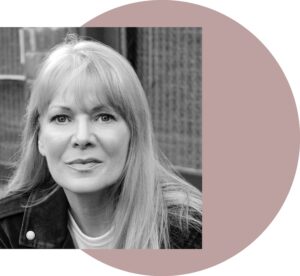 Mary Otis is the author of the novel Burst (Zibby Books), which won the 2023 Silver Medal in Literary Fiction from the Independent Book Publisher Awards. Burst was featured on PBS NewsHour and named by Good Morning America, New York Post, and The Orange County Register as one of the Best Books of 2023. Mary has also published a short story collection, Yes, Yes, Cherries (Tin House). Her stories, essays, and poems have been published in Best New American Voices, Tin House, Electric Literature, the Santa Monica Review, ZYZZYVA, McSweeney’s, and Bennington Review, among other journals and anthologies. She is also long-listed for the Joyce Carol Oates Prize. Mary previously taught creative writing in the UCLA Writers’ Program and was a founding fiction professor in the UC Riverside Low-Residency MFA Program. Originally from the Boston area, Mary lives in Los Angeles.
Mary Otis is the author of the novel Burst (Zibby Books), which won the 2023 Silver Medal in Literary Fiction from the Independent Book Publisher Awards. Burst was featured on PBS NewsHour and named by Good Morning America, New York Post, and The Orange County Register as one of the Best Books of 2023. Mary has also published a short story collection, Yes, Yes, Cherries (Tin House). Her stories, essays, and poems have been published in Best New American Voices, Tin House, Electric Literature, the Santa Monica Review, ZYZZYVA, McSweeney’s, and Bennington Review, among other journals and anthologies. She is also long-listed for the Joyce Carol Oates Prize. Mary previously taught creative writing in the UCLA Writers’ Program and was a founding fiction professor in the UC Riverside Low-Residency MFA Program. Originally from the Boston area, Mary lives in Los Angeles.
SEARCHING FOR HOME AND COMMUNITY
IN A NEIGHBORHOOD WHERE NO ONE CAN AGREE WHO BELONGS
by Mary Camarillo
Those People Behind Us is set in the summer of 2017, after the Trump election and before the pandemic, which seems like a long time ago. So many things have changed since 2017 yet too many things remain the same.
The story takes place in the Prestige Haven tract in Wellington Beach, California, a suburban coastal town increasingly divided by politics, protests, and escalating housing prices, as so many communities are these days. These divisions change the lives of five neighbors all struggling with financial problems, rebellious teenagers, aging parents, loneliness, and grief.
The Prestige Haven tract in Wellington Beach is a fictionalized version of my neighborhood in Huntington Beach, where I’ve lived for almost thirty years. Although Huntington has a very specific character and an often-notorious reputation, I believe the story in Those People Behind Us could be set anywhere in the United States. “Those people” is an expression I find myself using all too frequently.
This story developed during the pandemic when the gyms were closed. For exercise and entertainment, my husband and I walked our neighborhood and made-up stories about what we observed. We heard someone pounding on a drum set and decided it was a kid who dreamed of rock and roll fame. One of our neighbors always left all of their doors wide open, day and night, and we wondered why they were so careless. We were also curious about the flags our neighbors flew, what they thought about, and how they spent their days.
We saw a lot of suburban wildlife on our walks–coyotes, possums, skunks, raccoons, crows, hawks, herons, hummingbirds–and started paying more attention to the types of trees and plant life. Most of these ideas came together in this novel.
Those People Behind Us is told in rotating points of view from five different characters who are all searching for home and community in a neighborhood where no one can agree who belongs. Here’s a little from each character’s point of view. Keith Nelson is the first character we meet.
Keith watches a skunk family march down the middle of Summertime Lane, their eyes glowing zombie red in the streetlight. It’s 5:20 a.m. and the battery on his cell phone is almost dead. He can smell himself, perspiration, pizza breath, and the gym socks and towel that never quite dried yesterday. No matter what, he’s got to do laundry today and get some sleep tonight. He had to move his car from the library parking lot earlier, when the police drove through, flashing blue lights at the parked cars and RVs, yelling into bullhorns that the lot was closed. Now he’s only two blocks away from the house he grew up in.
Keith pees in an empty Gatorade bottle, opens the car door as silently as possible, and gets out. The blooms on the crepe myrtle trees up and down Summertime Lane catch the sun rising over Ensillado Mountain. He pours the urine out over the grass clippings in the Gormans’ green yard waste container, then puts the empty Gatorade bottle in their blue recycling bin. Stretching his arms overhead, Keith hears his neck pop. He wishes he had an Advil.
The crepe myrtle flowers are beautiful—watermelon red, rose pink, deep lavender, fuchsia, and white—with a silver bark that glows in the sunrise. A small breeze picks up and the blossoms wave back and forth as if they’re admiring each other. His dad would call him a pussy, but he loves these trees, the contrast of their crazy colors against the concrete sidewalks and driveways.
And then the Gormans’ sprinklers go on and an icy jet of water shoots straight up his leg. “Fuck,” he whispers as he jumps across the meridian, trying to avoid getting his feet wet too.
Keith is living in his Honda Accord, and he frequently parks near his parents’ house in the Prestige Haven tract because it’s familiar, it’s relatively quiet and he loves the trees. Keith gets solace from nature but his tendencies toward violence combined with his poor choice of friends have landed him in trouble his entire life. He’s twenty-four now and trying to keep a tight lid on his emotions by following a strict workout routine but his anger is always there, just below the skin, ready to erupt. He’s too muscular to fit comfortably in that Honda. He isn’t comfortable anywhere.
Ray Murdoch lives in the house behind Keith’s parents. Ray is a Viet Nam vet, caring for his aging mother who is one of the original homeowners in this once more affordable neighborhood.
Ray glances up and down the street at his neighbors’ driveways. It looks like a luxury car lot. Two matching BMWs next door. A tricked-out Lincoln Navigator parked beside a brand-new minivan across the street. That new couple halfway down the block has a black Mercedes, gleaming under the streetlight. Ray has counted five Teslas, three Airstream trailers, four Jeeps, and a Hummer on his bike rides around the neighborhood. Vehicles worth more than he ever made in a year. His neighbors are all about the show. They probably make fun of him for living with his mother and driving a sixteen-year-old Camry, but he doesn’t care. He doesn’t even know most of their names.
He supposes the general lack of neighborliness might also have something to do with the Hillary flag his mother insisted on buying as soon as she saw the Trump flag next door. The election is over, but the flags are still flying. Ray doesn’t remember any political signs when he was growing up. He never had any idea of how people voted or who they were for or against. Now everyone advertises exactly how they feel about everything when they’d all be better off not knowing. Ray remembers a line from a poem he had to memorize in grade school about good fences making good neighbors. He never really understood what it meant until now.
The black Mercedes Ray sees from his upstairs window belongs to the new couple down the street, the Larsens. Jeannette Larsen is an aerobics teacher; her husband Bob is an auditor and they’ve recently experienced a horrific tragedy. Bob thinks moving to the Prestige Haven tract will give them a much-needed fresh start. Jeannette is too numbed by guilt and grief to know what she needs.
The Saint Benedict bells chime twice on Saturday afternoon as Jeannette follows Bob out of their front door to the Mercedes in the driveway. There’s no one outside, except an older heavyset neighbor a few houses down, watering his rose bushes with a hose. The man waves, so she waves back. “Maybe we should stop and introduce ourselves.”
“Maybe we should keep some distance,” Bob says. “I doubt we have much in common anyway.”
They drive out of the tract toward the ocean, and she stares out the window at the mile after mile of cinderblock walls covered with creeping fig.
“Don’t you love this?” Bob asks when they turn left on the coast highway.
“It’s pretty,” she says, watching the Mexican fan palms sway and the waves crash against the pier. Like a postcard, she thinks, from someone else’s vacation.
Josh Kowalski is sixteen years old and lives on the same street as Ray and Jeannette. Josh’s father recently walked out on him and his mom, and Josh is dealing with this abandonment by slamming on a drum set and setting things on fire. This scene takes place the morning after a concert where Josh tried shooting flames for the first time and ended up burning his hand and getting caught by his mother.
Josh eats four untoasted Pop Tarts and washes them down with half a carton of orange juice. He can still taste lighter fluid in the back of his throat. There’s a note on the counter from his mother reminding him to work on the front yard. She’s decided grass is too expensive to water, feed, and cut and wants to put in drought tolerant plants. It’s thankless work, ripping out clumps of crabgrass and some kind of spiky thistle. He hasn’t made much progress.
He puts a Band-Aid over the burn on his hand, pulls on gloves, and goes outside. It’s a typical June Gloom morning, the sky slate metal, the neighborhood silent except for the church bells at Saint Benedict’s, ringing out 9:00 a.m. Empty sidewalks and concrete driveways outline tiny plots of lawns up and down the street. The houses are all different shades of beige. This is the most boring place in the world.
The fifth character, Lisa Kensington, would not agree with Josh’s assessment of the neighborhood. She loves where she lives and she’s not happy with Josh’s mother’s plan to rip out their front lawn. Lisa is a real estate agent whose territory is the Prestige Haven tract. She’s very much in the sandwich generation, juggling her job, her shopaholic husband, a mother-in-law who knows how to push all of her buttons and two teenagers with ideas of their own.
Lisa is fully invested in making sure the property values in the Prestige Haven neighborhood continue to rise and her treasured beach lifestyle doesn’t change. She walks the streets daily, keeping her eye on untended lawns, dusty cars, and trash cans left out on the street too long. She writes and hand delivers copies of a newsletter with helpful household hints, upcoming garage sales and discount offers on plumbing fixtures.
Lisa is always polite and professional and careful not to say what she might be thinking, which is often quite cringeworthy. Here’s a bit of her internal dialogue as she walks around the neighborhood, planting American flags in her neighbors’ front yards in preparation for the Memorial Day holiday.
Thank goodness there aren’t any sober living places or Airbnbs in the Prestige Haven tract. It’s a “homogenous neighborhood,” she occasionally admits to the clients who look like her, laughing hesitantly about being politically correct, not wanting to offend anyone and lose the sale, because you can never tell these days what people will take offense to. That’s why it’s a huge mistake for people to put up political flags. It’s so divisive. Like tends to follow like, after all. Everyone is more comfortable among their own kind. It’s just human nature. There is some diversity in Prestige Haven, of course. Two Indian women wearing saris push baby strollers through the neighborhood, but they speak English in a lovely musical tone. Lisa doesn’t really mind those kinds of foreigners, especially when they have cute dogs.
There are also two interracial couples who seem nice enough, and a few Asians who keep to themselves and could possibly be caregivers for the “normal” residents. So far, no one’s added any pagodas or elephants, unlike neighborhoods in nearby Fountain Springs, which are almost entirely Asian now; too many cars in the driveways, residents talking to each other in some foreign dialect. How’s that supposed to make people feel? How can you not think they’re talking about you? It’s certainly not neighborly.
One fair critique I hear frequently about my work is that my characters are not always “likeable.” I agree with Claire Messud, author of The Woman Upstairs who famously said, “If you’re reading to find friends, you’re in deep trouble. We read to find life, in all its possibilities.” I’ve always been attracted to characters who are flawed, keep secrets, think things they aren’t proud of, and say and do things they later regret. People I don’t understand as well as people I recognize. People like me.
The characters in Those People Behind Us all make assumptions about each other without knowing or trying to imagine what might be going on in their lives. By the end of the novel, these neighbors allow themselves to find a small amount of empathy for each other and realize they have more in common than they ever imagined. Empathy seems in short supply these days in the increasingly divided United States, where we all tend to listen to those that we agree with and make assumptions about people we don’t really know but have only observed from a distance.
When Community of Writers faculty member, Victoria Patterson, read Those People Behind Us she noted that it “uncannily captures the class struggles, insularity, status quo, xenophobia, and conformity of its real-life geographical counterpart in Orange County” yet she still found herself “unabashedly rooting for the fallible and suffering Wellington community.”
Allowing a small amount of empathy might help all of us all increase our understanding of whoever it is we refer to as “those people” and instead, recognize them as our neighbors and fellow human beings. And maybe we can even learn to root for them.
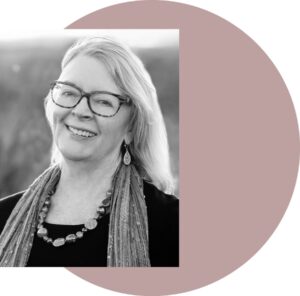 Mary Camarillo is the author of the award-winning novels Those People Behind Us and The Lockhart Women. Mary’s poems and short fiction have appeared in publications such as TAB Journal, 166 Palms, Sonora Review, and The Ear. Mary lives in Huntington Beach, California with her husband, who plays ukulele, and their terrorist cat Riley, who makes frequent appearances on Instagram.
Mary Camarillo is the author of the award-winning novels Those People Behind Us and The Lockhart Women. Mary’s poems and short fiction have appeared in publications such as TAB Journal, 166 Palms, Sonora Review, and The Ear. Mary lives in Huntington Beach, California with her husband, who plays ukulele, and their terrorist cat Riley, who makes frequent appearances on Instagram.

In late August, as tropical storm Hillary cloaked Southern California, I shuttled my sister from coastal Orange County, down the I-15 corridor to Menifee. We traveled to visit a long-time family friend – a sort-of second mother to us – who had recently moved to assisted living.
Despite the ominous predictions for the storm, the drive turned out to be non-eventful. Our reservations about assisted living facilities were also quelled. The place was, well, luxurious. Most importantly, our family friend (I will call her Emily) was in good spirits, sharp, present, and hospitable – just as we always remembered her. She had been through months of medical trials and was recovering, a noteworthy feat for someone a couple of years shy of ninety.
While Emily’s sister offered us tea and cakes, Emily recounted her previous months of health concerns. As with most medical issues, the diagnostic phase, and the prolonged period of not knowing, proved to be trying. Early in the process, Emily was told that she may have Amyotrophic lateral sclerosis (ALS), an awful prospect. As she described it, “You become trapped in your own body.” She told us that, with the possibility of a life diminished by ALS ahead of her, she’d considered opting out.
As her sister tried not to listen, Emily detailed to us in her polite, midwestern manner, her research into euthanasia. Emily had given the matter ample consideration, she spoke concisely about methods, timing, possible legal hurdles and, most importantly, how the subject was verboten with her family. Fortunately, for Emily, she did not have ALS and she never had to follow through on her research. However, Emily’s frank discussion of the matter, and learning that Emily had even considered euthanasia, was unexpected.
I grew up on a wide suburban street in Riverside, California. My family attended the same Catholic church as Emily and her family. I went to Catholic school with Emily’s children. Catholic doctrine, as I was taught, forbids ending one’s life. Even permitting someone to end your life, or encouraging someone to end your life, is forbidden. The one exception being martyrdom. Martyrs were the stalwarts when it came to faith, and their stubbornness often provoked their slayers. In the case of St. Sebastian, he provoked the pagans and their arrows at least once (perhaps twice?) and not only received special benediction, but also became the subject of fanciful paintings.
Per Catholic theology, suicide is a sin. However, as we learned in middle school religion class, there are exceptions. Those who lack the capacity to make clear decisions – are not in their right minds – get a free pass. As a legal matter, suicide has been mostly decriminalized. Thankfully so, if only considering the absurdity of such laws. However, euthanasia has historically received a less than eager reception in the U.S. Recall the vilification of Dr. Kevorkian – “Dr. Death” – and the lengths he went to skirt criminal convictions for his work with the terminally ill.
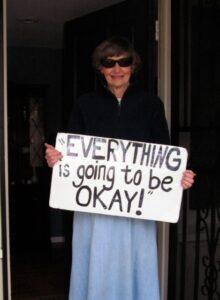
My late mother, a nurse, and a follower of church doctrine always took issue with euthanasia. Life is sacred. However, her views about care for the dying evolved as she grew older. When my grandmother’s cancer became terminal – radiation and chemo no longer even a consideration – my mother was angry about the resistance to providing necessary pain medication. It was hard enough to watch her mother die, but watching her die in pain was horrific. My mother unsuccessfully lobbied the hospital staff to provide my grandmother with more pain medication – anything to make it better. The experience of watching my grandmother die a difficult and painful death inspired my mother to work for hospice, and to become a strong proponent of palliative care. By the time my mother became terminal herself, she was completely on board with taking morphine, whatever it took, she wanted it. This was, of course, a relief for her three children. We were with her in the last days, my mother on a potent cocktail of morphine and lorazepam, resting peacefully until she died. No pain, no anxiety. We were relieved that she was afforded the dignity of a peaceful end.
Obituaries necessarily recount the high points of one’s life – the milestones, the achievements, the follies etc. – with a short mention of the cause of death. Besides the requisite “was in the presence of loved ones” there is little accounting of the actual death. However, when I read obituaries, I often think about what the final days could have brought for the memorialized individual. Anyone who has watched someone die knows the process can be tough if not brutal. It does not have to be. When folks offered condolences for my mother, my sisters and I were quick (and proud!) to report that the process was as good as one could hope for (understanding that we all knew the ending beforehand).
Accepting the need for hospice care, and palliative care takes one down a slippery slope to euthanasia. Give someone enough morphine for pain and, eventually, it may kill them. However, to my knowledge, hospice is not allowed to administer an overdose, or fatal dose of pain killers. For obvious reasons, our medical system is designed to keep folks alive. No one goes to medical school to learn how to kill people. But the catch is that, whether we like it or not, there is in every case a point when medicine will no longer be successful. This is a difficult consideration for many to reckon with. One may remember when the Affordable Care Act tried to add cost saving measures to end of life care and congressional opponents to the bill began screaming about death panels. That was silly and disconcerting, if emblematic of how we struggle with the process of dying. We have plenty of discussions about life, death, and life after death, but the subject of how we eventually succumb, the final hours, the final mechanism, does not make good cocktail hour chatter. Our failure to acknowledge how death can be unnecessarily brutal has kept euthanasia out of mainstream acceptability.
Things change, however. California passed the End-of-Life Option Act in 2016, which was modelled on Oregon’s Death with Dignity act. The California act became law (after court challenges) in 2018. Brittany Maynard, the brave 29-year-old with terminal cancer, was forced to travel to Oregon to pursue euthanasia. Brittany inspired the California statute. The catch for both the California and Oregon law is that the patient must self-administer the lethal cocktail – No Dr. Death at the bedside. California law also requires the diagnosis of terminal illness.
Which brings me back to Emily. When faced with a possible diagnosis of ALS, I believe she realized she might be diminished to a point where she could not self-administer her own lethal end, and then be trapped in her body, a sort of purgatory. Emily told us that her research turned up helium as a recommended solution – it is readily available, not a controlled substance, and fatal in sufficient doses. Of course, Emily’s joke was that, after a fatal dose of helium, one’s final words would arrive in ear-piercing frequencies. Death with dignity and hijinks. Donald Duck voice aside, helium renders an image of lightness. There are far worse destinies than taking flight as a balloon. Perhaps the best we can hope for is that eventually we will all be able to simply float away.
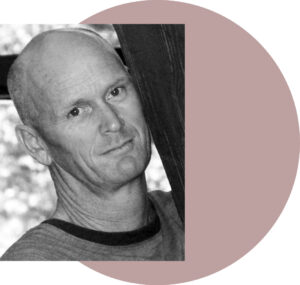
David Womack is the author of Mountain Bike! Orange County and The Stand-Up Paddler’s Guide to Southern California. He attended the Screenwriting program in 1997 and 2001, and lives and works in Laguna Beach.

TAILS OF THE CITY
by Diana Fuller
“History and Amazement”: Screenwriting Director Diana Fuller on her documentary, Tails of the City, with stills from the film, which recently screened at the San Francisco Short Film Festival
Mixed breeds find love, laughter and mutual pleasure when sharing common ground at a public dog park.
This film is a visual realization of a place and its moment through the eyes of dogs and their parents. We produced it to bring to the attention of an audience hungry for gentle pleasures as now, at last, the coronavirus becomes containable. As shown in our documentary, it is constantly proven — by dogs and their people! — that the past only helps to define the present and that we must remember to live in the now.
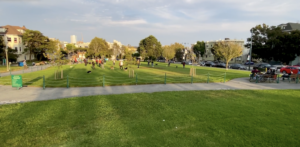 San Francisco’s Duboce Park, between the Duboce Triangle and Lower Haight neighborhoods, is a legendary place, a little like a town square. It is said there was once a spring there, at the corner of Duboce and Sanchez, which fed the lake which the Spanish called Dolores or “Sorrows” because they discovered it on March 29, the feast of Our Lady of Sorrows. Hence the mission with the same name. Less than one block wide from north to south and two blocks wide from west to east, its western boundary is Scott Street, and its eastern boundary is Steiner Street, with Duboce Avenue to the south. The place has acquired a certain magic and become a vibrant social center for those living around it, and their dogs, who are allowed off leash.
San Francisco’s Duboce Park, between the Duboce Triangle and Lower Haight neighborhoods, is a legendary place, a little like a town square. It is said there was once a spring there, at the corner of Duboce and Sanchez, which fed the lake which the Spanish called Dolores or “Sorrows” because they discovered it on March 29, the feast of Our Lady of Sorrows. Hence the mission with the same name. Less than one block wide from north to south and two blocks wide from west to east, its western boundary is Scott Street, and its eastern boundary is Steiner Street, with Duboce Avenue to the south. The place has acquired a certain magic and become a vibrant social center for those living around it, and their dogs, who are allowed off leash.
Daily visitors to Duboce Park create a manifestation of this magic as four-legged, two-legged, and sometimes three-legged beings cavort daily — running, jumping, chatting, barking, licking, and scratching. Visitors gossip dutifully amidst the tumbling and leaping of the new pandemic puppies who can’t wait to embark on their new adventures.
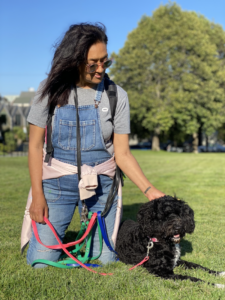 Four little streets in the area dead-end at the park. Each street has its own character. One seems always to echo the laughter of young children playing after school. One hosts concerts on an almost weekly basis. Another kind of vibrates from the grating and roar of roller skates rolling back and forth by mostly beginners, followed by occasional shrieks. Another seems to be under perpetual repair. Yet dogs are everywhere!
Four little streets in the area dead-end at the park. Each street has its own character. One seems always to echo the laughter of young children playing after school. One hosts concerts on an almost weekly basis. Another kind of vibrates from the grating and roar of roller skates rolling back and forth by mostly beginners, followed by occasional shrieks. Another seems to be under perpetual repair. Yet dogs are everywhere!
Of course, every neighbor has a story. Every family of a dog and owner has a background. And in these collaboratively magical circumstances, everybody shares. The daily noon parade is mainly for puppies and trainers, but the park clears by one o’clock, and it’s back to work. But at five PM the cares of the day seem to disappear, and the neighborhood rolls out again, hungry for laughs and smiles, filling with the people and their pets who live in the area. The number of visitors to this bespoke new neighborhood ebbs and flows but a large contingent remains steady as the daily visits, necessitated by — inspired by — our pets, have become a part of our lives. Conversations ensue. Common subjects are health — that of dogs and humans — food and politics — always politics! — the cost of vet bills and ailments, always about the changes in the city, and of course always about each very personal if sometimes shared engagement with history and amazement.
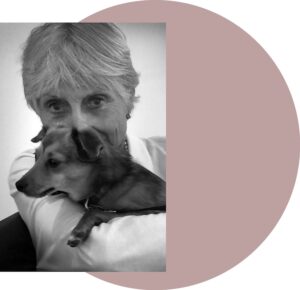 Diana Fuller is a freelance curator, editor, and producer of Rift, Racing to Zero, Once Was Water. She is the ongoing director of the Screenwriting Program at the Community of Writers. She is the editor of Art/Women/California 1950-2000: Parallels and Intersections, published in 2004, by University of California Berkeley Press. She has been curator for contemporary art exhibitions for 40 years. She serves on the Boards of the Community of Writers, the The Artists in Residence Program at Recology and the Conflict Awareness Project. She was the last president of the Film Arts Foundation and past Chair of the Roxie non-profit theater.
Diana Fuller is a freelance curator, editor, and producer of Rift, Racing to Zero, Once Was Water. She is the ongoing director of the Screenwriting Program at the Community of Writers. She is the editor of Art/Women/California 1950-2000: Parallels and Intersections, published in 2004, by University of California Berkeley Press. She has been curator for contemporary art exhibitions for 40 years. She serves on the Boards of the Community of Writers, the The Artists in Residence Program at Recology and the Conflict Awareness Project. She was the last president of the Film Arts Foundation and past Chair of the Roxie non-profit theater.

FOUR POEMS
by Violeta Orozco
Atlas of an Ancient World is a book rising up from the earth, from the rocky realms of volcanoes and oceans, where seashells, corals, obsidian, basalt stones and cacti are still today sacred to many brown and black people in the Americas who seek to record our intimate attachment to this land. Like songs tying us to memory, these objects are talismans of power connecting us to the story of the ecosystems we have inhabited for centuries, the sacred sites where our origin stories are written on our skin. Atlas of Ancient World maps the sacred cartographies of the inhabitants of lakes and estuaries, oceans and mountains, the world of cosmic inheritance for diasporic Chicanx, Latinx and migrant people, as well as for those of us who seek to acknowledge those who stand behind us. For those of us who know that the past is also the direction of our future.
MOUNTAIN DAHLIA / EL PIRUL
In memory of the mountain where I used to play as a child, now replaced by a large mall
“If we are brief as lightning in the arrow-shaped
wisp of cloud—” Naomi Shihab Nye
Shielded under the memory
of the longest brevity we may ever be
we will dream clearer sources
gather
rainwater to pour into the dam
so when they slaughter this hill
some may remain
folded in the flowers
straw dahlias
growing on the edge of every mountain sensing death
they will wave pink heads,
sway long stalks into the air.
If we are brief enough to remember every tree
leaves will hold the memory of our sight
rebuild themselves after they have left our mind
California pepper trees still will send seeds
years after they have been cut down.
Howling winds will feel the emptiness of skies
that have lived a long time with mountains.
By then we will have taken
the fifteen species of cacti into our hands
cradled their delicate thorns in our raw skin
their displaced bodies will take over our gardens
bringing back butterflies and crickets who fled
this crumbling patch of land
knowing
this brevity
still carries
scent of pink peppercorns from a native tree:
el pirul
a burning pungence
traveling
through these warm hands.
ATLAS OF AN ANCIENT WORLD
A former library book made its way into my hands
like a shoaled fish all the way from Lubbock, Texas
the word “Discard” branded upon its back,
ink seared into the flesh of each page.
It was called “Peoples and Places of the Past”
as if it had been written in a perpetual present
that could never see itself with marveled eyes,
a book so unwieldy I had to use a horse
to carry it home, turn the first page,
let history unfold in tales of gypsum caves and Anasazi pottery,
lake villages of adobe and stone.
How many years did the book spend
lying upon the patient shelves of the public library?
waiting for a shy reader to wander into its pages
admiring the eons it took to be formed
like a sedimentary stone
gathering geological memories of the earth
all the way to this era of human writing.
For how long, so many of us were waiting
for those words, climbing down dead craters
to read the injured surface of the planet.
It was rumored that once the book was reopened,
the sacred bison would repopulate the land
if rubbed with the right ointment on the paper.
No longer living in a cloistered world
obsidian traders and cockleshell hunters
decided to remove their knowledge
from the stone slabs of the ancient canyon.
Let them figure it out themselves
the wise women said, rowing away
from the islands, we will keep our oracle
for our private use. Why should we sell what we still need?
They took their dead with them
stowed wild rice in rafts
settled the other half of the world
one where no grains or crops would prosper.
They refused nostalgia, dwellings for the departed.
The word came across early enough
etched in the back of a condor:
empires had spent too much time
worshiping death,
they had lost the connection
to their celestial power,
ceased to nourish themselves with flowers and cacti
learn from the heart of plants
listen to the throb of woodlands and deserts
highlands and far away coasts.
This is the story of their story.
Let us trade tales like beads, and listen.
TLACUILA AT SERPENT MOUND
For many years I was afraid of the language of seers and curanderas,
so akin did it seem to the language of death.
I did not want to be the dream-gazer, uttering auguries like nightmares
stories of dismembered deer dripping into the sky,
forming The Constellation of Quetzalcóatl,
feathered serpent cunning astronomer,
looter of ancestor bones in a jade bowl.
I was only a Tlacuila, a humble female painter transcribing
oak moans and rumbles in the deep forests of the mind.
I never saw myself as harbinger of hope or faith
not having grown in a world of saints but of spirits
dwelling inside mountains and oceans,
my language the murmur of creeks and winds beating
upon the highest peaks. When I reached Serpent Mound I did not see
the former denizens of this Ohio land. They were silent
like dead scattered barns splayed in a midwestern town
where “effigy mound”, “geoglyphs” and “ceremonial grounds”
were nothing but feeble signs trying to explain to the white gaze
why they should drive this far, how this burial site
was still full of life and memory
even after the Adena or the Hopewell disappeared.
They, who like the serpent-loving people of Aztlán,
traded obsidian blades for turquoise
bird-shaped pendants,
imported grizzly bear teeth from the Rockies,
carved shell beads from Florida to adorn the neck of the buried.
Across valleys and hills, they hammered copper into falcons,
thin mica sheets from the Appalachian Mountains
into undulating serpents and hawk talons.
This was no ossuary or graveyard,
but a dream-vessel sheltering the last of their buildings,
earthworks of a forgotten architecture
Enduring
everything infused with movement
Snake
Sycamore
Stream
down the trail
slither swiftly
whirl
into the coil of time
eagle-traced map of dreams
path of swallowed stars
where silver
maples gaze down
at the pulsing water.
DREAMTIME / WOMAN HOLDING ATLATL
Lightning woman streaks angry stars across the sky.
Who can see her silhouette?
armed, walking through the night,
glittering jade and malachite
flash like fireflies decking caverns
long hidden from human sight,
tree rings count
floating whorls of liquid time.
Cave paintings show spears
piercing a tree’s heart, billowing clouds
protect the rain she grows
with lightning bolts
even now that her ancestors buried
her blunt machete into the dry earth.
Under naked dawn light shining on woven tapestries,
women in outdoor markets trade coyote furs,
visions overlap in celestial mountain kingdoms.
A fox cuts loose from the painting, unfolds limbs,
leaps into a third dimension untouched.
He lands inside our world where we may kill
whatever we fear or dream to be too close.
How to return to that dreamworld?
where songs like talismans are worn
without shivering, proudly around our throat,
where hail and lightning
are hurled by a woman etched into stars
hollering into the closing threshold of the hours
thundering worlds too deaf to see her shaft
too blind to ask who the hailbearer may be,
how she cleaves screech from dream,
constellation from dreamtime.


TO PHILIP SCHULTZ WHO DIDN’T WRITE FROM 1984 TO 2002
by Sommer Schafer
I haven’t been writing a lot over the past couple years, though the ideas tumble in moments. Yes, I will do it, I think on my trail run, besot by a compelling idea that germinated at Bull Frog Trail and came to a near bud three miles later, about halfway to the dead valley oak of the end. On these runs, I’m overtaken by the landscape that is full of language—the chunkiest dark eyed junco I’ve ever seen, there and then gone in a coyote bush, which is a line that leads to the trail that is a loopy line between thick redwoods possessing their own lines deep crevices up and down; lines that I sometimes pause to grasp between thumb and fingers, feeling the redwoods’ language, remarkably soft and buoyant, coarse, of course, between the hot pads of my fingers, me holding onto it as if it were my husband’s hand. Suddenly, I’m drawn up to the line of the red-tailed hawk, cree-ing in the cloudless sky, and follow the return of my shoes to the language of the line of the trail, spitting me out to a trail above a valley gone to summer brown and sage sweet.
When I return, the yes, I will do it, has become a forgotten memory that will return on the next run, and the idea will bud, and I will instead be overtaken with the language of everything else—the bird, the bee, the trunk, the raptor, the snake, the toyon heavy with red berries, the toyon released of them, the madrone heavy with red berries, the madrone released of them.
Since I was a kid, I wrote, just constantly. So many of you are nodding your heads—I feel it! It’s wonderful being among you who understand such an urge. Stories, essays, filling journal after journal after journal. Oh, the world! Oh, people! There was so much there that was confusing, irritating, beautiful, ecstatic. Those words will never see the light of day. Do they matter? Now in my late forties, I’m trying to remember—in my bones, in that space between heart and throat—what it was like. To write and write for only oneself. For the pure and supreme joy of it alone.
I have published my first book! A collection of short stories. Aren’t those always a bugger to get out in the world. I have written a novel and two novels-in-stories. I have had several literary agents solicit me after reading a story or two in lit mags. Yet. The novels aren’t quite exactly the thing. The thing to match—no, outmatch! —the greatest thing in the universe as we know it.
In the Winter 2018 issue of The Gettysburg Review, Philip Schultz writes for a special Tribute to Peter Stitt: “For reasons I still struggle with, I stopped writing poetry from 1984 to 2002 and didn’t publish a book for eighteen years.”
These days, I seem to want silence. Great big pauses between my lines. I want to jump from here to there with nothing in between. I want the reader to make that transition herself, perhaps. Or what? There is something in the silence, the nothing between here and, now, there.
To Philip Schultz, you must forgive me. For jumping in—it’s what we writers do, don’t we? But first, thank you. Thank you for being so truthful—for taking one for the rest of us stuck (or soaring or stewing or angry or in love with or) in our non-writing. We love you.
This is how it went, though it absolutely did not.
You had two books already published, a third no one wanted because it’s never ever a given. Why? Who knows. The topic wasn’t right for the time; no one wanted poetry anymore; it just wasn’t quite the thing. You weren’t a novelist. Small presses started going under because who can afford it, this tireless, serious, quiet, anti-capitalist venture in a world stuffed full of noise and big bucks and an ever-widening gap between the rich and everyone else. Big ones wouldn’t touch it with a ten-foot pole. Someone close to you died; your marriage started to wane and then bubble and burst, spewing burning liquid, and then back again. Or a lover left. Kids grew up. The books don’t pay the bills, and the teaching barely, and what a time-suck at times soul-suck it is. Or there was no teaching, there was something else. Someone you thought was a friend just wouldn’t be there; family liked to make you think you had lost, had always lost, your mind, were fraught with unspeakable troubles. Suddenly, everywhere you looked were people suffering from their egos and laying suffering upon others. You wanted to close your eyes and weep. The sun had been so bright, and now it was dim. You were assessed for cataracts that were not there. Healthiest eyes ever.
Still, you sat down, in the beginning; same desk, same light, or a different desk, a different light; the same view or a different one out an adjacent window that every so often you turned to, looked out to, and after so many months, so many years of this, you realized that you had fallen utterly in love with that view, those trees, the clouds across that sky, the pileated woodpecker that accosts the oak to this day. It is your view, and you are its.
You wrote.
Thousands, thousands, and thousands of words. There would be a third book, dammit! There had to be. There were multiple books in those words, and they were good books. And you remember just about every single line, every single poem, every essay, every scribble, which, because they seemed to be the words of a fool doing the same thing over and over again though she meets with failure, began to seem tiresome and dull. Absolutely meaningless. You began to question your presence, in the literary world, amongst peers, at the grocery store, in life. It was a slow process. It was not writing every day, and then writing once a week. It was going three months without and then three hours one weekend in a burst of forced creativity, which left you feeling refreshed, ecstatic, as it always does, and you wondered, why don’t I do this regularly, where has my discipline, my sense of meaning, gone? But then, half a year went by, a year. Eighteen.
At last, you called it what it was.
You gave up.
You turned your body, your eyes, your mind, your indelible spirit, to the language of the woods, the wide-open air brisk across your face, the nonsense of the songbirds, the heroics of the raptors, the chorus of fungi and roots below the roiling soil. The antics of your hilarious kids. The love of your spouse. The sounds of the wind through the crowns of the redwoods, which is the softest loudest sound you’ll ever hear.
And then, it came back to you.
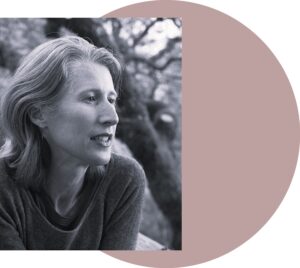 Sommer Schaffer is senior editor of The Forge Literary Magazine and widely published. She lives in Northern California on Coast Miwok land with her family, a rescue dove, and a bearded dragon. Her first book of short stories, The Women, was released by Unsolicited Press on November 14.
Sommer Schaffer is senior editor of The Forge Literary Magazine and widely published. She lives in Northern California on Coast Miwok land with her family, a rescue dove, and a bearded dragon. Her first book of short stories, The Women, was released by Unsolicited Press on November 14.

FAQ
by Steve Almond
Adapted excerpt from Truth is the Arrow, Mercy is the Bow: A DIY Manual for the Construction of Stories by Steve Almond. © 2024 by Steve Almond. Used with permission of the publisher Zando, LLC. All rights reserved.
FAQ
Q: What is your writing process?
A: Many bongs ago, a Famous Writer came to visit my MFA program. His book of stories had just won the Pulitzer Prize, so he was arriving, really, from Planet Fame, a place we could see at night, flickering in the vault of heaven. At some point during his visit, the Famous Writer informed us that he wrote for at least four hours every day.This length of time was the bare minimum necessary for him to reach the spiritual plane upon which he could commune with his characters. His tone was resonant, faintly Buddhist. For the next decade or so—between bouts of Writer’s Block—I wrote for at least four hours every day. I produced two excruciating novels and many excruciating stories. Mostly, I sat in misery, watching the large, industrial clock I’d stolen from the university library. 3:41. 3:47.
I understand the urge to shake down more established writers for their trade secrets. But your process belongs to you. Do a self-inventory. When and how do I write best? Early mornings? Late nights? Long stretches or short bursts? Coffee or wine? Think about the circumstances that prevailed when you com- posed your truest work. Seek to replicate them. This will require management. You have to design your schedule to protect those windows.
As your life changes, your process will change. When I was a single dude, I could spend hours staring at stolen clocks. Now I have three children and a partner with her own creative needs, and bigger bills to pay, and less energy, less bandwidth. That may sound like a set of complaints. It’s really just a list of conditions. I have to be more focused and enforce clear boundaries around my creative time. My wife and I have to flee the clamor of our home to do sustained work. We take turns.
I can’t control whether the muse will visit or not. Neither can you. Your goal isn’t to attain some mystical state. It’s simply to show up, as best you can, to put yourself in a position to make decisions at the keyboard.
Q: When am I allowed to call myself a Writer?
A: Whenever you like. The question itself, though, suggests a yearning for legitimacy. My advice is to avoid the noun and emphasize the verb. Like any other title, the noun links to status, thus hierarchy, thus ego. I still avoid telling people I’m a writer. It sounds presumptuous, like I should carry a feather quill. Those are my hang-ups, of course. If you find it empowering to identify yourself as a writer, go for it.
I prefer the term Word Decider, which describes the activity rather than the identity. It’s kind of nerdy, and only a partial description—we are also plot deciders, syntax deciders, character deciders—but if I ever print up a business card, that’s the phrase I’ll plunk beneath my name. Word Decider.
Q: Can you recommend a literary agent?
A: Once upon a time, an agent wrote me out of the blue, to solicit a piece for a rather silly anthology. I asked how much he could pay. Alas, he responded, there was no money in it for contributors. So who is getting paid, I wondered. Our email correspondence continued for a while, in that murderously polite manner that prevails when one party refuses to answer simple questions. Eventually, the agent admitted that he and his coeditor had received a $50,000 advance. Any payment over $500 would put them in the red, he argued, and any payment under $500 “would be pointless.”
I’m telling you this story to emphasize that writers and agents live in different worlds. The writer is an artist. The agent is a broker. I understand why writers place so much stock in acquir- ing an agent. It’s a vote of confidence and a badge of legitimacy in a realm fraught with rejection and insecurity. Securing representation is not a ticket to the dance, though. It’s the beginning of a process by which your art is brought to market.
An agent offers expertise and connections. They also add another layer of emotional bureaucracy to the submission pro- cess. Rather than worrying about not hearing from editors, you get to worry about not hearing from your agent. The whole sys- tem is predicated on keeping writers in the dark. Agents and publishers don’t want us to take on the burdens of negotiation, or learn too much about our own contracts, or pitch editors directly.
Ideally, agents do more than broker. They serve as advocates, editorial advisors, even business managers. They earn that 15 percent. But no agent is going to pluck you from obscurity. That will be accomplished by your hard labor, all the tough, beautiful decisions you made alone in some room. Remember that. Hold on to it.
Q: What’s your stance on simultaneous submission?
A: It’s irresponsible to submit work to more than one magazine/ editor/agent, if the recipient forbids multiple submissions. But also: you, the writer, have invested a lot more time in your work than they have. It’s understandable that you don’t want to wait months for a single rejection before you submit again. This was how I rationalized sending out multiple submissions back in the day.
So I don’t have a hard-and-fast rule here.
But I do want to note the power dynamics around submis- sion, because—as the name implies—it’s the process where you, the control-freak author, lose control.
Rule one: Don’t send out a draft. You’re asking someone with a giant stack of manuscripts to invest in your work.
Rule two: Disappointment is the essential risk. Your ego, and your faith, may take a hit. Be real about that, especially if you’re feeling fragile.
Rule three: You probably won’t get closure. Rejection usually means a form letter, or a set of bromides.
Rule four: You cannot win if you don’t buy a ticket.
Back in grad school, I published a few stories in literary journals, and made sure everyone knew. What I never con- fessed was that I’d received a hundred rejections for every acceptance. The only other person in our program who knew this was the poet and essayist Camille Dungy, who house-sat for me one summer and received my mail. Camille has told this story for years. The reason I got my work published wasn’t because I was a better writer than my comrades. It was because I bought more tickets.
Rule five: All you can control is your decisions and (on good days) your reactions. The world decides the rest.
Q: Does withholding information build suspense?
A: The simplest way to answer this is by explaining the difference between surprise and suspense. To do so, I’m going to steal a riff from my pal, the novelist Bruce Machart.
- Let’s say you have the poor fortune of being enrolled in one of my workshops. I walk in to class on the first day and run my mouth for three hours. Then, at the very end of class, I pull a paintball gun from my satchel and shoot you in the face.
Surprise!
But let’s say, on the other hand, that I walk into class on that first day and open my satchel and pull out the paint gun and set it on my desk and say, “One of you is going to trigger me today. It happens every class, I’m afraid. And when it happens, I’m not going to scowl at you, or make a note in my grade book. I’m going to wait till the end of class and then pick up this paintball gun and, in front of everyone, blast you in the face.”
Now ask yourself: In which version of the class am I going to pay closer attention? The first one, in which the calamity comes as a shock? Or the second one, in which you are apprised of the risk upfront? That’s the difference between surprise and suspense.
Q: Is it ever OK to confuse the reader?
A: Yes. If your protagonist is confused, for instance. The reader should participate in that confusion. The sworn enemy here is confusion that prevents the reader from understanding, and thus participating in, the world of the characters.
When I was editing a literary magazine, this was the most common reason we rejected stories—because we were lost. “Where are we?” we asked ourselves. “What’s going on? Who’s telling this story? What’s in it for them?” We spent the pivotal early moments struggling to orient ourselves, rather than bond- ing with the characters. Then we gave up.
Q: Should my writing make money?
A: Your motives are your own, of course, as are your circumstances. But to the extent possible, I advise you to uncouple artistic creation from financial expectation. The voices in your head when you write should be helping you tell the story, not sell it.
Q: Can my first draft be a mess?
A: Yup.The first one is for you. It’s your chance to shake down your unconscious, to see what comes loose and what sticks, to take chances, to duck down blind alleys, to get lost.
Q: How much research should I do?
A: Enough to bring us inside your characters—and not one iota more.
The qualifier is crucial, because you may be tempted to hide in your research, hoping that if you just “do your homework,” the people in your stories will come alive. That’s not how it works. Your research should be directed by who your characters are, what they desire and fear, how they see the world.
Maggie O’Farrell’s 2020 novel Hamnet is spellbinding not because she vividly portrays Elizabethan England, but because she brings us inside the sensual, lived experience of our protagonist, Agnes Shakespeare. We smell, taste, touch the domestic and botanical realms central to her role as mother and healer, while, in a welcome twist, her famous husband remains offstage, tending to his plays in London.
During one virtuosic passage, O’Farrell traces the transmission of bubonic plague from a flea-infested monkey in Alexandria, Egypt, all the way to the Shakespeare homestead in Warwickshire. This meticulous viral accounting presages the tragedy at the heart of the novel: the death of Agnes’s son, young Hamnet. O’Farrell wears her research so lightly it doesn’t feel like research at all. It’s just a remarkable tale.
This applies equally to nonfiction projects. If you’re writing a memoir set in a country that has undergone social and political upheaval, that history is an integral part of the story. If you’re going to write a book questioning the morality of football, as I did some years ago, you had better get your facts straight. Curiosity should serve a devotion to the truth.
Q: What about finding my voice?
A: Voice is what emerges when you stop performing, when your voice on the page flows from your voice off the page, its particular rhythms and vernacular and sensibility. As you reveal more forms of expression, your voice grows more supple. You can be blunt and vulnerable, sad and funny, erudite and vulgar.
Consider a young American writer living in Paris some years ago. He’s produced two serious novels and is at work on a third when, one sunny morning, heading to his studio, he notices the water released from the fire hydrants tracing the curbs in iridescent currents. It is, he thinks, “just the sort of thing that makes us loonies cheerful.” He resolves, then and there, to allow him- self as much freedom of movement as that water.
The result is The Adventures of Augie March, whose delirious prose marks the liberation of Saul Bellow from the prison of respectability. At last, the full range of his personality reaches the page, the wise, profane voices he absorbed growing up, the infectious cadences of the four languages spoken in his home. Forget “finding” your voice. It’s there already, in the hydrant of your past, awaiting release.
Q: Is it cool if I check the internet real quick?
A: Of course. It’s your life. But remember: writing is an attention racket. If an open browser is enough to tempt you out of your story, don’t expect the reader to stay in it.
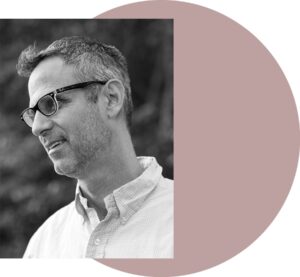 Steve Almond is the author of eleven books of fiction and nonfiction, including the New York Times bestsellers Candyfreak and Against Football. His essays and reviews have been published in venues ranging from the New York Times Magazine to Ploughshares to Poets & Writers, and his short fiction has appeared in Best American Short Stories, The Pushcart Prize, Best American Mysteries, and Best American Erotica. Almond is the recipient of grants from the Massachusetts Cultural Council and the National Endowment for the Arts. He cohosted the Dear Sugars podcast with his pal Cheryl Strayed for four years, and teaches Creative Writing at the Neiman Fellowship at Harvard and Wesleyan. He lives in Arlington, Massachusetts, with his family and his anxiety.
Steve Almond is the author of eleven books of fiction and nonfiction, including the New York Times bestsellers Candyfreak and Against Football. His essays and reviews have been published in venues ranging from the New York Times Magazine to Ploughshares to Poets & Writers, and his short fiction has appeared in Best American Short Stories, The Pushcart Prize, Best American Mysteries, and Best American Erotica. Almond is the recipient of grants from the Massachusetts Cultural Council and the National Endowment for the Arts. He cohosted the Dear Sugars podcast with his pal Cheryl Strayed for four years, and teaches Creative Writing at the Neiman Fellowship at Harvard and Wesleyan. He lives in Arlington, Massachusetts, with his family and his anxiety.

ABOUT THE OGQ
Omnium Gatherum Quarterly (OGQ) is an invitational online quarterly magazine of prose and poetry, founded in 2019 as part of the 50th Anniversary of the Community of Writers. OGQ seeks to feature works first written in, found during, or inspired by the week in the valley. Only work selected from our alums and teaching staff will appear here. Conceived and edited by Andrew Tonkovich. Submissions will not be considered.


